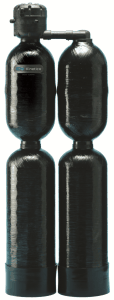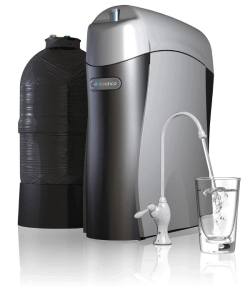SITUATION:
This was a relatively common for Mukwonago area. The family was seeing the typical high-levels of iron and the catalyst for the call was that they were seeing staining in toilets, tubs, and sinks even with the water softener in the home.
WATER TEST & PLUMBING AUDIT RESULTS
After testing the water at this families home, we confirmed that issue and identified a couple of problems.
Iron Issues
The total iron was over 3.5 parts per million (ppm). Like many wells, some of the iron was in the soluble/ferrous state, some was in the insoluble/ferric state. For them, the breakdown was 1.5 ppm of the ferrous type–a functioning softener will remove this. The other 2 ppm were in the ferric state.
That form of iron will just fly through the water softener and was the root cause of the staining. The general rule of thumb is that iron will stain at around 0.3 ppm. So for this family, that 2 ppm is almost 700% of the iron required to stain.
Water Softener
The water softener was “working.” Working is a tough decision. They were using well over 100 pounds of salt per month on just 13 grains of hardness. For context, on our Premier S250 series softener, their consumption should have been closer to about 20 pounds of salt per month.
Reverse Osmosis
The reverse osmosis system had failed. The total dissolved solids (TDS) were at 374 ppm on the raw water. The water coming from the RO was at 57. That’s less than 85% of the solids being removed.
THE FIX
There are two ways to address their problems. The softener is somewhat working, it just isn’t working well and it’s on its last legs. The operating cost on the softener is about an extra $10/month in salt.

Kinetico 4060 – Combination Softener and Filter
There is a partial fix that remedies the iron problem: Add an iron filter. With our oxidizing iron filter put before the softener, we can reduce some of that waste. It will eliminate any iron (both forms) and reduce the salt demand on the softener to an extent. It’s less expensive in the short-term, more expensive in the long-run as the softener is nearing end of life.
The real fix is the Kinetico 4060 Macrolite softener. It’s slightly less expensive than most companies’ combo of an iron filter + a single-tank old style softener; however, it picks up the high efficiency of the Kinetico non-electric, twin-tank (quad tank in this setup) design.
When it comes to drinking water, it’s really hard to have the Kinetico K5 Reverse Osmosis system and not recommend it. This young family has utterly unsuitable drinking water coming from an extremely old reverse osmosis system. An <85% rejection on an RO system will indicate that something is going on. These microscopic tears in the membrane offer a path of zero-resistance for contaminants and organisms to get through. Specific to those microorganisms, they then hit a carbon filter where they have time to regroup and multiply.

Kinetico K5 Drinking Station
With the K5 Reverse Osmosis, paired with the consistently soft water from the Kinetico 4060 system, both systems run a full 10 year warranty, including the membrane.
That’s unheard of in the water industry to the point where most companies not only don’t warranty the membrane, they force you to buy a new one every 12 months.
You might have some, all or none of these problems. As always, give us a call or click through the quick form to request an in-home, no-cost analysis of your water and options.
